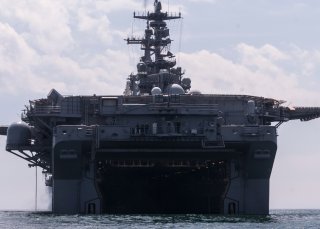Drone Motherships: Navy Gets Serious About Unmanned Submarines
Although the United States Navy has already cut steel on its newest class of submarines, there is a pressing need for underwater vessels that don’t put sailors' lives at risk in contested environments.
The United States Navy’s San Antonio-class amphibious warships are preparing for a new kind of mission: deploy, maneuver, and then recover large-diameter unmanned undersea vehicles, also known as LDUUVs.
In a press release, Huntington Ingalls Industries, an American shipbuilding and defense company, explained that they “performed the launch and recovery demonstration with a prototype platform called Pharos and HII’s LDUUV Proteus,” and added that “the demonstration took place in the Pascagoula River.”
San Antonio-class ships, built by Huntington Ingalls, “have unique well decks that can be flooded to launch and recover various maritime platforms. The U.S. Navy has previously demonstrated the ability to recover spacecraft from the amphibious warship well deck,” which lends them well to large underwater vehicle recovery.
Huntington Ingalls explained that the demonstration involved “having the LDUUV approach and be captured by the Pharos cradle, while Pharos was being towed behind a small craft that simulated an amphibious ship at low speed. Pharos was put in a tow position, then using a remote control, it was ballasted down in the trailing position allowing the LDUUV to navigate into Pharos. Once the unmanned vehicle was captured, Pharos was deballasted back up into a recovery and transport position. The demonstration also included ballasting down to launch the LDUUV after the capture.”
The statement from the company added that “Pharos is outfitted with heavy duty wheels to allow its transport maneuverability within the well deck of an amphibious ship for stowage on the vehicle decks. Pharos can be rolled off the back of an amphibious ship while using the ship’s existing winch capabilities to extend and retract the platform from the well deck. The Pharos design is scalable and reconfigurable to fit various unmanned underwater or unmanned surface vehicles.”
Though the Pharos exercise was just a demonstration, Huntington Ingalls explained that it will use the information gleaned from the event “to further mature concepts and continue to develop innovative national security solutions.”
Although the United States Navy has already cut steel on its newest class of submarines, the upcoming Columbia-class nuclear-powered subs, there is a pressing need for large unmanned underwater vehicles that don’t put sailors' lives at risk in contested environments.
By leaning on unmanned underwater vehicles for some mission profiles, the Navy hopes to leverage new technologies and perhaps accomplish tasks that a large manned platform cannot.
Caleb Larson is a multimedia journalist and defense writer with the National Interest. A graduate of UCLA, he also holds a Master of Public Policy and lives in Berlin. He covers the intersection of conflict, security, and technology, focusing on American foreign policy, European security, and German society for both print and radio. Follow him on Twitter @calebmlarson.
Image: DVIDS.

